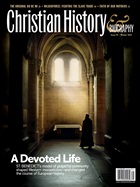Praying in the New World
Within two hours after the Jamestown settlers landed in Virginia, their Anglican minister built a makeshift church by "nailing a piece of timber between two trees," and stretching "a square of sailcloth over it." Thus, on May 13, 1607, they attended their first prayer service in the New World.
Captain John Smith, leader of this group of British entrepreneurs, described services under the "old saile" as "more like the real praising of God, than any he had ever heard in the costly buildings of the old world."
That was 400 years ago. Throughout 2007, the Virginia Commonwealth is celebrating the anniversary of this first permanent English settlement in North America with several special events including a main gala on May 11-13.
Unlike the later Puritan colony at Plymouth, the Jamestown group was driven less by faith than by gold and other material ends. Still, most (if not all) of the settlers were members of the Church of England. In the midst of hunger, conflicts with the Indians, sickness, and internal dissension, the colonists attended daily morning and evening prayer, heard two sermons on Sundays, and received Communion every three months.
Some Jamestown settlers tried to convert the Indians to Christianity. From the beginning King James I had admonished them to proclaim the "Christian religion to such people as yet live in darkness and miserable ignorance of the true knowledge and worship of God …" They were largely unsuccessful, but with a few notable exceptions—including the native princess Pocahontas.
You can visit the Jamestown Settlement, a reconstruction of the fort, ships, and an Indian village—all complete with costumed interpreters. Down the road is the original Jamestown site, where an impressive ongoing archaeological dig is open to visitors. Visit www.Americas400thAnniversary.com for more information.
Hug a tree or save a church?
California's historical treasures include its 21 missions. The state's natural wonders include its famous redwoods. Last year, the city of Monterey weighed the continued existence of the state's oldest continuously functioning church against the well being of four beautiful, but much younger, redwoods.
The Cathedral of San Carlos Borroméo sits on the site where, in 1770, Franciscan missionary Junipero Serra and Governor Gaspar de Portolá established a mission and a presidio, or fort. The next year, Fr. Serra moved the mission five miles away to Carmel. However, the Monterey structure continued to function—first as a military chapel, then as a parish church, and now as a cathedral. When the other California missions were secularized in the 1800s, the church on this site kept functioning. After fire destroyed earlier structures, the present building was completed in December 1794.
The cathedral needs renovation. Moisture has affected its stone foundations (the shade from the redwoods keeps them from drying out). And tree roots have penetrated to the opposite side of the church. Originally, the city of Monterey suggested a compromise: take out only two of the trees and find a way to cap the roots of the others.
But, according to Cathy Leiker of the Royal Presidio Chapel's conservation office, an archaeologist found additional treasures beneath the trees: the floor of the soldiers' barracks, portions of the old presidio's walls, and the floor of an early baptistery. Because there was no way to keep the trees and preserve both the church and the buried archeological treasures, the city agreed that the trees had to go.
Recycling the classics
Scientists are using a high-energy x-ray beam to read a tenth-century greek text that was scraped and reused by a later scribe.Would you pay $2 million for a book made of recycled paper? You might if the "recycling" was the work of a 13th-century priest, and underneath the later writing was the earliest known copy of lost works by the ancient Greek mathematician Archimedes.
Medieval scribes who copied manuscripts couldn't just go to the stationers for their materials. They often had to reuse parchment or vellum made from animal skins. Fortunately, those materials were sturdy enough that they could be scraped and bleached and still be used again. Such a reused manuscript is called a palimpsest (from Greek words meaning "scraped again").
The scarcity and expense of writing materials always made it tempting to reuse parchment and vellum. So the ecumenical synod of 691 (the Council in Trullo) banned the cutting up or "corruption" of manuscripts of the Scriptures or the church fathers—unless they were already hopelessly worm-eaten.
A few months ago, the Los Angeles Times reported on a reused piece of sheepskin parchment. A Stanford University physicist had adapted his technique for studying iron molecules in spinach leaves to reveal traces of iron-based ink used in the nearly erased original writing. Under an even later bit of forged painting on the manuscript, he found the signature of the scribe who had turned the ancient mathematical treatises into a prayer book. On the edge of the first page, it said "By the hand of presbyter Ioannes Myronas." It was dated April 14, 1229.
The 348-page, $2 million manuscript was first written in Constantinople and rewritten in Palestine. It now resides in Baltimore at the Walter Art Museum.
Beautiful books
It's a legendary scene: a medieval monk crouches over his parchment as he meticulously copies and illustrates sacred texts. A new exhibition at the J. Paul Getty Museum in Los Angeles traces the production of illuminated manuscripts in France, where they have historically been a significant art form.
During the early Middle Ages, monks used their manuscripts for public worship, private devotions, and scholarly pursuits. Monasteries were centers of prayer and learning. By the 13th century, the demand for books increased and professional artists took up the task of manuscript production. Soon the most popular book became the Book of Hours, a devotional prayer book for laypeople.
The exhibition, "French Manuscript Illumination of the Middle Ages," includes 25 manuscripts from the Getty's collection and highlights achievements from the 800s to the 1500s. The exhibit opened January 23 and continues through April 15, 2007.
Copyright © 2007 by the author or Christianity Today/Christian History & Biography magazine.
Click here for reprint information on Christian History & Biography.

Support Our Work
Subscribe to CT for less than $4.25/month





























